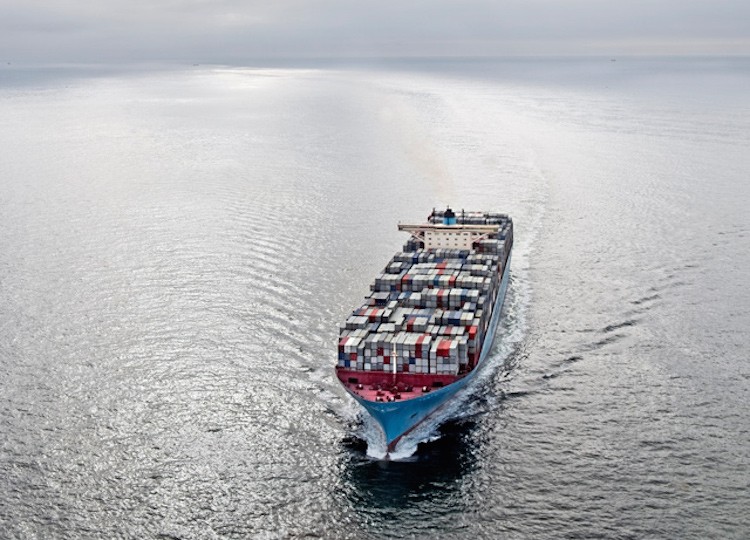Firms in Fed’s Beige Book Fret Over Any Lengthy Baltimore Port Closure
(Bloomberg) — The closure of one of the East Coast’s busiest ports after the collapse of Baltimore’s Francis Scott Key Bridge has so far not led to broad price increases,...


Photo: Maersk Group
![]()
![]()
COPENHAGEN, Nov 6 (Reuters) – Shipping and oil conglomerate A.P. Moller-Maersk said on Friday third-quarter profit almost halved and global demand for container transportation this year would grow at a slower pace than previously expected.
The Danish company, which operates the largest container shipping business in the world, kept a reduced forecast made two weeks ago for a 2015 underlying profit of $3.4 billion, down from the $4.0 billion previously expected.
Maersk has taken a double hit to its businesses — its oil units have floundered as crude prices halved since last year, while low trade volumes and an overcapacity of vessels have weighed on Maersk Line, the container shipping business.
The earnings report, which showed third-quarter net profit almost halved to $778 million from $1.5 billion a year ago, comes two days after Maersk Line said it would slash costs, cut staff by almost a fifth and pull out of some vessel orders.
On Friday, the company said it now expected demand for seaborne container transportation around the world to grow 1-3 percent this year, lower than its previous view of 2-4 percent.
Growth in demand for shipping, at 1 percent in the third quarter, is the lowest since the 2008 financial crisis that hit the industry particularly hard. Maersk made an annual loss in 2009, the only year it has lost money in its 111-year history.
Though the global economy has recovered since, trade volumes have risen at a slower pace than in the past and economists are increasingly concerned about flagging growth in China.
Overcapacity has exacerbated that situation – in 2015, Maersk expects a 9 percent growth in container shipping capacity, outstripping the around 1-3 percent growth in trade.
That leads to a slump in freight rates. On the busiest routes in the world, from China to Europe, spot rates this year have been at barely profitable levels. This week they fell 32 percent to $674 per container, a source with access to data from the Shanghai Shipping Exchange told Reuters.
Despite the dire conditions, Maersk Line has been one of the most profitable shipping companies around thanks to its scale and cost cutting, and the group’s third quarter results were in line with forecasts.
“Maersk is definitely under pressure at this hour, but this is an absolutely worst case scenario situation, so I’m quite optimistic because Maersk is still able to generate 3.4 billion (dollars) in profit in such a year,” said Sydbank analyst Jacob Pedersen. “Maersk is still in front in the market.”
At 1135, GMT shares in A.P. Moller-Maersk were up 0.3 percent, compared with a 0.6 percent fall in Europe’s blue-chip index
CONSOLIDATION?
Chief Executive Nils Smedegaard Andersen said consolidation within the shipping industry, which is largely operated by state- or billionaire-owned companies, would be natural during the slump.
“We have for several years expected consolidation. It has not happened but it would be a natural thing since many players are loss-making,” he said during a conference call.
The industry is awash with consolidation talk. Shares in China’s Cosco have been suspended since Aug. 10 and industry insiders expect its container shipping unit to merge with China Shipping Container Lines (CSCL) to create the fourth largest shipping company in the world.
Meanwhile, Singapore’s state investor has put its majority stake in Neptune Orient Lines (NOL) up for sale, with shipping industry websites reporting that a tie-up with newly-listed Hapag-Lloyd was in the offing.
South Korea’s government has also asked Hanjin Shipping to look for a partner, said Jan Tiedemann, an analyst with shipping consultancy Alphaliner.
“(Consolidation) will have a huge knock on effect as all of these carriers have alliances. That would be the end of the alliance as some will be too big for regulatory reasons or too small to compete,” he said. “It’s very difficult to see what the global shipping landscape will looks like.” (Additional reporting by Annabella Nielsen; Editing by Mark Potter)
(c) Copyright Thomson Reuters 2015.
Join the gCaptain Club for curated content, insider opinions, and vibrant community discussions.


Join the 105,932 members that receive our newsletter.
Have a news tip? Let us know.
Access exclusive insights, engage in vibrant discussions, and gain perspectives from our CEO.
Sign Up




Maritime and offshore news trusted by our 105,932 members delivered daily straight to your inbox.



Essential news coupled with the finest maritime content sourced from across the globe.
Sign Up